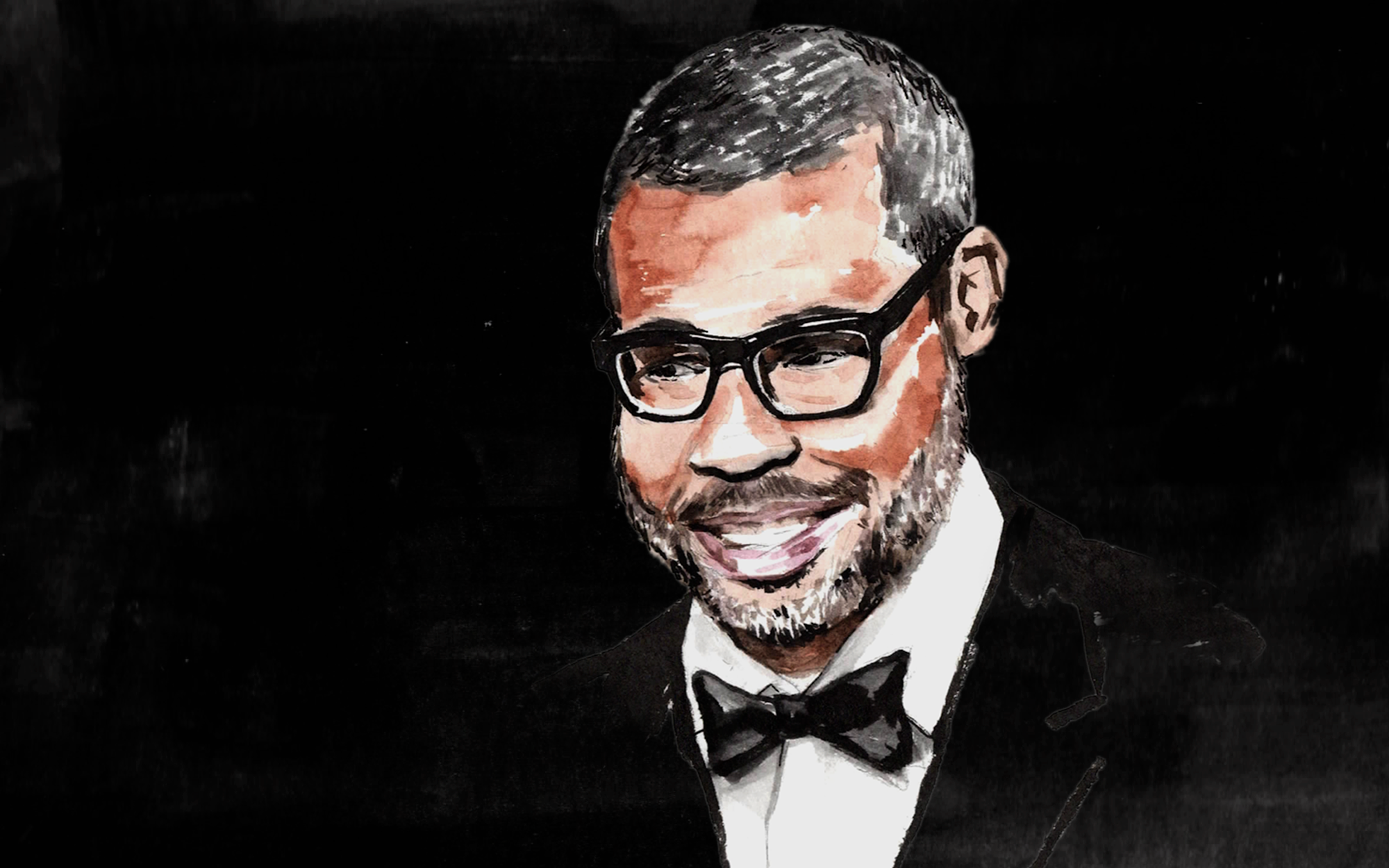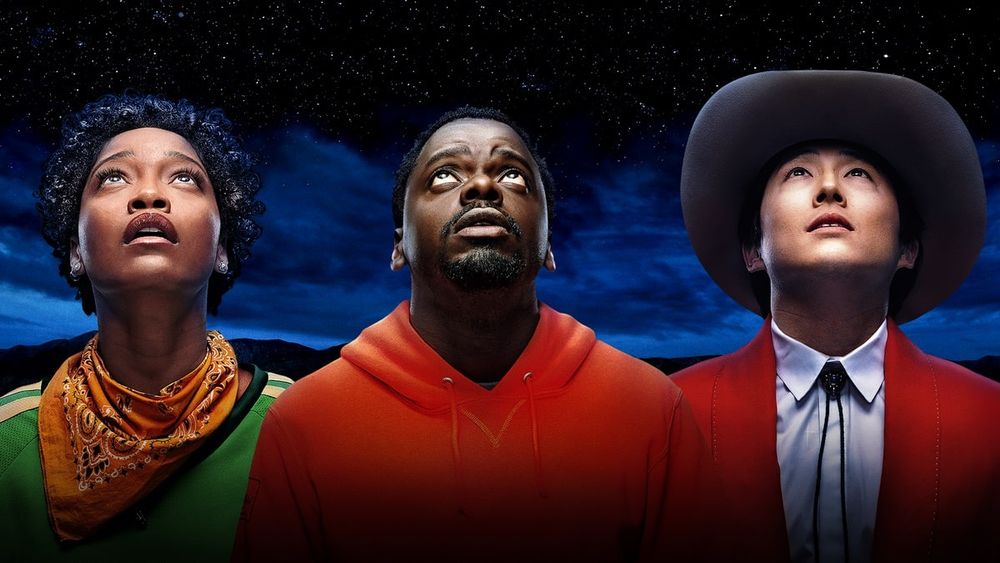Regardless of how you feel about horror movies, aliens, or black art, Nope is a film you should go see, and soon, before content creators ruin it for you. Jordan Peele once again created a film you shouldn’t hear about secondhand—how many things can we say that about anymore? His films are famously unspoiled before release, so you get to experience all the surprise the director intended. And Nope is a buffet of upended expectations.
The story starts off straight forward: Siblings OJ (Daniel Kaluuya) and Emerald Haywood (KeKe Palmer) unexpectedly and gruesomely lose their father (Keith David), leaving them to take care of the family business, the preeminent (and perhaps only) Black-owned horse training company for Hollywood films and TV shows. While trying to make ends meet, they discover they’re not alone in their part of the valley town of Agua Dulce. Odd things start happening around the ranch, culminating in the appearance of a UFO. They hatch a plan to capture the alien ship on film to make some money, and after some fairly scary developments, enlist the help of a local tech salesman named Angel (Brandon Perea) and world-weary film director Antlers Holst (Michael Wincott). Things go slightly awry from there.
Of the three films Jordan Peele has directed, this will be the most divisive. This film is different in almost every way from his first two films, Get Out and Us. Those are intimate films. They’re firmly race films. They both use traditional horror tropes—body snatching and slasher tools in varying degrees—so their missions are clear. Both have very strong political and social messaging about race and class.
Nope is none of those things. Its antagonist is epic in scale. It has huge action scenes. Its messaging is present, but deftly massaged into the narrative so as not to broadcast or distract. Peele has come into his own as a director and a storyteller, looking to take the well-worn idea of alien invasion and flip it into a satisfying mash of unpredictability. Much like the horses at the Haywood ranch, we’ve been trained to expect Peele’s movies to be experiences that have to wash over you, that you cannot assume anything about before going in. Even his trailers are sleight of hand.
And let’s be honest: Half of whatever hate this film receives will be from people who are mad they got stole on by the trailer. They thought it was going to be a movie about alien abductions. All of the signs were there. When the movie delivers something else and every image that they saw in the trailer turns out to mean something else—the UFO, the scarred woman, the creepy beings in the barn, the monstrous hand reaching out to a child—they realize they’ve been had. My advice to them is, don’t be mad. Concede that you are in the hands of an intelligent storyteller and go along for the ride. Accept that Peele is always trying to put something into the world that it has not seen before, which means your predictions are probably not going to pan out, no matter what they are. Don’t be upset because you thought you were going to a water park and Peele took you to Disney World.
This is the first Jordan Peele movie that truly demands a second viewing for the purpose of acquiring a full appreciation of its craft. His other films generated multiple viewings because we wanted to see what we liked about them unfold again. Nope is different. It doesn’t have Easter eggs so much as neatly tucked clues that must be seen at least twice to appreciate in real time. When OJ mentions setting up a payment plan to buy back some of his horses from Western amusement park owner Ricky “Jupe” Park (played with impish perfection by Steven Yeun), the hitch in his reaction feels like a business tic. Jupe pivots to once again offering to buy the Haywood ranch. You don’t catch on first viewing that the pause comes, not from a capitalist place, but from the knowledge that he can’t physically honor a restorative plan with the Haywoods. The film has several such tips of the hat that require multiple viewings or photographic memory to appreciate.
For a film that comments on everything from race to social media to the heaping amounts of self-destruction to be found in hubris, Peele's style is a risk. Whether or not that risk pays off will come down to the viewer.
Of course, like all of Peele’s films to date, there are hanging threads that aren’t cleanly resolved. What’s with the upright shoe? Do we need the chimp story told the way it is? What part does the cloud play? I suspect some of these threads are intentionally left untied, but not all of them. That said, there’s so much to chew on here visually (this movie is beautiful to look at) I don’t care that I don’t know everything walking out the door.
Here’s a bit of free game when assembling a puzzle: Find all of the edge pieces and put them together first. That way you know the scale of the picture you’re attempting to piece together. While I am certain Jordan Peele loves a good puzzle, and Nope is his best puzzle yet, he isn’t a borders kind of director. If the puzzle has an errant dog, a red door, and a moon in the sky, Peele is the kind of puzzler who puts those sections together and then saves the border for last. He doesn’t mind putting together a scene out of time, several times, and stringing you along until the end to see how it all fits. For a film that comments on everything from race to social media to the heaping amounts of self-destruction to be found in hubris, his style is a risk. Whether or not that risk pays off will come down to the viewer.
Peele said in a recent interview that people like “movies more than messages.” He’s right, and more, he proves he’s right. As a writer and a Black man, he understands that some things are inherent the minute you add Black people to the mix. Peele is especially adept at making a political statement by not only avoiding the nail head, but without using a hammer at all. Early in the film there is a recreation of the first motion picture in history: a two-second clip of a Black man riding a horse. As a side quest, Nope seeks to tell the story of that jockey through the legacy of the Haywood family, with the perhaps not entirely unintended effect of restoring the Black roots to cowboy history. The Haywood family business as presented doesn’t exist—there is no preeminent Black owned horse training company that operates at the scale of the business in this film. The Haywoods are a Russian doll of Black legacy, blurring the lines of fiction and history. Or rather, showing that so much history is what we make it. The filmed becomes the filmmaker, and by the end, just seeing OJ astride a horse becomes a revolutionary image. The jockey lost to history has finally come home.
OJ and Emerald come off as opposites—the stoic and dour versus the amped and kinetic—but the performance decisions of Kaluuya and Palmer suggest their relationship is more complementary than oppositional. When they comically low-five each other in rapid succession without a miss, you get that it is an act of love that has happened a hundred times before. Emerald doesn’t have to draw OJ out of his shell to make that act happen; it is their thing, and it is culturally automatic. What the movie lacks in obvious backstory it makes up for in these kinds of moments, which suggest the brother is the way he is because the sister is the way she is, and vice versa. When OJ is at a film shoot and Emerald isn’t there to speak to people, he doesn’t step up into his purpose or exert control over the situation; he shuts down. He needs his sister just to get to even-keel. She needs him to remind her that the twisters she regularly foments kick up real dust and debris.
To their credit, most reviewers aren’t trying to spoil Nope in their accounts. They are, however, willing to reveal obvious connections to a previous cinematic effort: Jaws. Jaws was the first film I ever saw in a theater. I was 4, and my oldest brother took me because he was always stuck babysitting his younger siblings while my mother worked. Since that fateful day in 1975, I have seen Jaws enough times to know when someone else has seen Jaws enough times to recite it back to me. I noted at least a dozen ways in which the two films align, but will leave those nuggets for other viewers to find. Trust me, there’s gold in them thar hills.
With Nope, Peele continues his mission of creating high-minded art that centers the Black experience, normalizes Black craft excellence, and meets foundational, classic art face-to-face and builds new legacies upon it. He has done John Henry, mountain-smashing work with what is, at its core, a summer popcorn movie.


